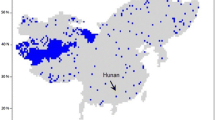Abstract
Climate change has greatly affected agriculture. Agriculture is facing increasing risks as its sensitivity and vulnerability to climate change. Scientific assessment of climate change-induced agricultural risks could help to actively deal with climate change and ensure food security. However, quantitative assessment of risk is a difficult issue. Here, based on the IPCC assessment reports, a quantitative method for risk assessment of agriculture due to climate change is proposed. Risk is described as the product of the degree of loss and its probability of occurrence. The degree of loss can be expressed by the yield change amplitude. The probability of occurrence can be calculated by the new concept of climate change effect-accumulated frequency (CCEAF). Specific steps of this assessment method are suggested. This method is determined feasible and practical by using the spring wheat in Wuchuan County of Inner Mongolia as a test example. The results show that the fluctuation of spring wheat yield increased with the warming and drying climatic trend in Wuchuan County. The maximum yield decrease and its probability were 3.5 and 64.6%, respectively, for the temperature maximum increase 88.3%, and its risk was 2.2%. The maximum yield decrease and its probability were 14.1 and 56.1%, respectively, for the precipitation maximum decrease 35.2%, and its risk was 7.9%. For the comprehensive impacts of temperature and precipitation, the maximum yield decrease and its probability were 17.6 and 53.4%, respectively, and its risk increased to 9.4%. If we do not adopt appropriate adaptation strategies, the degree of loss from the negative impacts of multiclimatic factors and its probability of occurrence will both increase accordingly, and the risk will also grow obviously.





Similar content being viewed by others
References
Bai HX, Li DY, Ge Y, Wang JF (2016) Detecting nominal variables’ spatial associations using conditional probabilities of neighboring surface objects’ categories. Inf Sci 329:701–718
Botts RR, Boles JN (1958) Use of normal curve theory in crop insurance rate making. J Farm Econ 40:733–740
Bruce JS, Fabio CZ, Gary DS, Scott HI (2004) Crop insurance valuation under alternative yield distributions. Am J Agric Econ 86(2):406–419
Dong ZH (1999) Establishing agricultural risk management system in China. J Zhongnan Univ Finance Econ 2:69–71
Gallagher PUS (1987) Soybean yields: estimation and forecasting with nonsymmetric disturbances. Am J Agric Econ 69:796–803
Goodwin BK, Mahul O (2004) Modeling concepts relating to the design and rating of Agricultural Insurance Contracts. Working Paper, World Bank
Goodwin BK, Roberts MC, Coble KH (2000) Measurement of price risk in revenue insurance: implications of distributional assumptions. J Agric Resour Econ 25:195–214
Hubig M, Muggenthaler H, Mall G (2014) Conditional probability distribution (CPD) method in temperature based death time estimation: error propagation analysis. Forensic Sci Int 238:53–58
Huo ZG, Li K, Wang SY, Liu JL, Xue CY (2003) Study on the risk evaluation technologies of main agrometeorological disasters and their application. J Nat Resour 11(6):692–703
IPCC (2001) Technical summary. In: White KS, Ahmad QK, Anisimov O et al (eds) Climate change 2001: impacts, adaptation, and vulnerability. Contribution of Working Group II to the Third Assessment Report of the Intergovernmental Panel on Climate Change. Cambridge University Press, Cambridge
IPCC (2007) Technical summary. In: Parry ML, Canziani OF, Palutikof JP et al (eds) Climate change 2007: impacts, adaptation, and vulnerability. Contribution of Working Group II to the Fourth Assessment Report of the Intergovernmental Panel on Climate Change. Cambridge University Press, Cambridge
IPCC (2012) In: Field CB, Barros V, Stocker TF et al (eds) Managing the risks of extreme events and disasters to advance climate change adaptation: a special report of Working Groups I and II of the Intergovernmental Panel on Climate Change. Cambridge University Press, Cambridge
IPCC (2014) Impacts, adaptation, and vulnerability. Part a: global and sectoral aspects. In: Field CB, Barros VR, Dokken DJ et al (eds) Contribution of Working Group II to the Fifth Assessment Report of the Intergovernmental Panel on Climate Change. Cambridge University Press, Cambridge
ISO (2009) ISO guide 73–2009. International Standards Organization, Geneva
Jones RN, Preston BL (2010) Adaptation and risk management: climate change working paper no. 15. Centre for Strategic Economic Studies, Victoria University, Melbourne, pp. 1–18
Li Y, Gao G, Song LC (2014) Understanding of disaster risk and the management associated with climate change in IPCC AR5. Progressus Inquisitiones De Mutatione Climatis 10(4):260–267
Lu L, Ding D, Deng HB (2012) Climate change: risk assessment and coping strategies. Rev Econ Res 20:19–22
Nelson CH, Preckel PV (1989) The conditional beta distribution as a stochastic production function. Am J Agric Econ 71:370–378
Qu ML (1991) Practice supervision of agricultural climate. Beijing Agricultural University Press, Beijing
Renn O (2005) Whitepaper on risk governance: towards an integrative approach Whitepaper No. 1 of the International Risk Governance Council
Wang K, Zhang Q (2013) The review and prospect of risk assessment methods on agricultural production. Agric Econ Outlook 2:38–43
Wu SH, Pan T, He SF (2011) Primary study on the theories and methods of research on climate change risk. Adv Clim Chang Res 7(5):363–368
Zhang JQ, Li N (2007) The risk assessment and quantitative management method of the main meteorological disaster and its application. Beijing Normal University Press, Beijing
Zhao SJ (2010) The risk assessment of rice flood disaster in Huai River basin driven by scenario. Proceedings of the 4th Annual Meeting of the Professional Committee on Risk Analysis of China Disaster Prevention Association. 392–399
Acknowledgments
This study was supported by the Non-profit Research Foundation for Meteorology of China (No. GYHY201506016), the National Basic Research Program of China (No. 2012CB956204), the National Natural Science Foundation of China (Grant Nos. 41371232 and 41271110), the Non-profit Research Foundation for Agriculture of China (No. 201103039), and the National Science and Technology Support Program of China (No. 2012BAD09B02).
Author information
Authors and Affiliations
Corresponding author
Rights and permissions
About this article
Cite this article
Dong, Z., Pan, Z., An, P. et al. A quantitative method for risk assessment of agriculture due to climate change. Theor Appl Climatol 131, 653–659 (2018). https://doi.org/10.1007/s00704-016-1988-2
Received:
Accepted:
Published:
Issue Date:
DOI: https://doi.org/10.1007/s00704-016-1988-2




